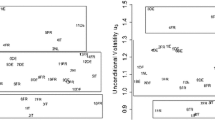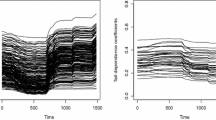Abstract
A methodology is presented for clustering financial time series according to the association in the tail of their distribution. The procedure is based on the calculation of suitable pairwise conditional Spearman’s correlation coefficients extracted from the series. The performance of the method has been tested via a simulation study. As an illustration, an analysis of the components of the Italian FTSE–MIB is presented. The results could be applied to construct financial portfolios that can manage to reduce the risk in case of simultaneous large losses in several markets.


Similar content being viewed by others
References
Bastos J, Caiado J (2013) Clustering financial time series with variance ratio statistics. Quant Financ (in press)
Bernard C, Brechmann E, Czado C (2013) Statistical assessments of systemic risk measures. In: Fouque JP, Langsam J (eds) Handbook on systemic risk. Cambridge University Press, Cambridge, pp 165–179
Billio M, Caporin M (2009) A generalized dynamic conditional correlation model for portfolio risk evaluation. Math Comput Simul 79(8):2566–2578
Billio M, Caporin M, Gobbo M (2006) Flexible dynamic conditional correlation multivariate GARCH models for asset allocation. Appl Financ Econ Lett 2(2):123–130
Bock HH (2011) Special issue on “time series clustering”. Adv Data Anal Classif 5(4):247–249
Bonanno G, Caldarelli G, Lillo F, Miccichè S, Vandewalle N, Mantegna R (2004) Networks of equities in financial markets. Eur Phys J B 38(2):363–371
Bradley B, Taqqu M (2004) Framework for analyzing spatial contagion between financial markets. Financ Lett 2(6):8–16
Brechmann E (2013) Hierarchical Kendall copulas: properties and inference. Can J Stat (to appear)
Brida J, Adrián-Risso W (2010) Hierarchical structure of the German stock market. Expert Syst Appl 37(5):3846–3852
Caiado J, Crato N (2010) Identifying common dynamic features in stock returns. Quant Financ 10(7): 797–807
Chen X, Fan Y (2006) Estimation and model selection of semiparametric copula-based multivariate dynamic models under copula misspecification. J Econom 135(1–2):125–154
Cherubini U, Mulinacci S, Gobbi F, Romagnoli S (2012) Dynamic Copula methods in finance. Wiley finance series, Wiley, Chichester
Corduas M, Piccolo D (2008) Time series clustering and classification by the autoregressive metric. Comput Statist Data Anal 52(4):1860–1872
Croux C, Dehon C (2010) Influence functions of the Spearman and Kendall correlation measures. Stat Methods Appl 19(4):497–515
Czado C (2010) Pair-copula constructions of multivariate copulas. In: Jaworski P, Durante F, Härdle W, Rychlik T (eds) Copula theory and its applications, vol 198, Lecture notes in statistics—proceedings. Springer, Berlin, pp 93–109
De Angelis L (2013) Latent class models for financial data analysis: some statistical developments. Stat Methods Appl 22(2):227–242
De Luca G, Zuccolotto P (2011) A tail dependence-based dissimilarity measure for financial time series clustering. Adv Data Anal Classif 5(4):323–340
De Luca G, Rivieccio G, Zuccolotto P (2010) Combining random forest and copula functions: a heuristic approach for selecting assets from a financial crisis perspective. Intell Sys Acc Financ Manage 17(2): 91–109
Dobrić J, Frahm G, Schmid F (2007) Dependence of stock returns in bull and bear markets. Discussion Papers in Statistics and Econometrics 9/07, University of Cologne, Department for Economic and Social Statistics. http://ideas.repec.org/p/zbw/ucdpse/907.html
Durante F, Foscolo E (2013) An analysis of the dependence among financial markets by spatial contagion. Int J Intell Syst 28(4):319–331
Durante F, Jaworski P (2010) Spatial contagion between financial markets: a copula-based approach. Appl Stoch Models Bus Ind 26(5):551–564
Durante F, Sempi C (2010) Copula theory: an introduction. In: Jaworki P, Durante F, Härdle W, Rychlik T (eds) Copula theory and its applications, vol 198, Lecture notes in statistics—proceedings, Springer, Berlin, pp 3–31
Durante F, Foscolo E, Sabo M (2013) A spatial contagion test for financial markets. In: Kruse R, Berthold M, Moewes C, Gil M, Grzegorzewski P, Hryniewicz O (eds) Synergies of soft computing and statistics for intelligent data analysis, vol 190, Advances in intelligent systems and computing, Springer, Berlin, pp 313–320
Embrechts P, McNeil AJ, Straumann D (2002) Correlation and dependence in risk management: properties and pitfalls. In: Dempster M (ed) Risk management: value at risk and beyond. Cambridge University Press, Cambridge, pp 176–223
Engle R (2002) Dynamic conditional correlation: a simple class of multivariate generalized autoregressive conditional heteroskedasticity models. J Bus Econ Statist 20(3):339–350
Everitt BS (1979) Unresolved problems in cluster analysis. Biometrics 35:169–181
Forbes KJ, Rigobon R (2002) No contagion, only interdependence: measuring stock market comovements. J Financ 57(5):2223–2261
Genest C, Favre AC (2007) Everything you always wanted to know about copula modeling but were afraid to ask. J Hydrol Eng 12(4):347–368
Glosten L, Jagannathan R, Runkle D (1993) On the relation between the expected value and the volatility of the nominal excess return on stocks. J Financ 48(5):1779–1801
Gordon AD (1999) Classification, 2nd edn. CRC, Boca Raton
Härdle W, Simar L (2012) Applied multivariate statistical analysis, 3rd edn. Springer, Berlin
Hubert L, Arabie P (1985) Comparing partitions. J Classif 2:193–218
Jaworski P, Pitera M (2013) On spatial contagion and multivariate GARCH models. Appl Stoch Models Bus Ind (in press)
Jaworski P, Durante F, Härdle WK, Rychlik T (eds) (2010) Copula theory and its applications. Lecture notes in statistics proceedings, vol 198. Springer, Berlin
Jaworski P, Durante F, Härdle WK (eds) (2013) Copulae in mathematical and quantitative finance. Lecture notes in statistics, proceedings, vol 213. Springer, Berlin
Joe H (1997) Multivariate models and dependence concepts, vol 73, Monographs on statistics and applied probability. Chapman & Hall, London
Jondeau E, Rockinger M (2006) The copula-GARCH model of conditional dependencies: an international stock market application. J Int Money Financ 25(5):827–853
Kaufman L, Rousseeuw P (1990) Finding groups in data. An introduction to cluster analysis. Wiley series in probability and mathematical statistics: applied probability and statisticsWiley, New York
Liao T (2005) Clustering of time series data—a survey. Pattern Recogn 38(11):1857–1874
Longin F, Solnik B (2001) Extreme correlation of international equity markets. J Financ 56(2):649–676
Malevergne Y, Sornette D (2006) Extreme financial risks. Springer, Berlin
Mantegna R (1999) Hierarchical structure in financial markets. Euro Phys J B 11(1):193–197
McNeil AJ, Frey R, Embrechts P (2005) Quantitative risk management. Concepts, techniques and tools. Princeton series in finance, Princeton University Press, Princeton
Milligan GW, Cooper MC (1985) An examination of procedures for determining the number of clusters in a data set. Psychometrica 50:159–179
Nelsen RB (2006) An introduction to copulas, 2nd edn. Springer series in statistics. Springer, New York
Otranto E (2008) Clustering heteroskedastic time series by model-based procedures. Comput Statist Data Anal 52(10):4685–4698
Pattarin F, Paterlini S, Minerva T (2004) Clustering financial time series: an application to mutual funds style analysis. Comput Statist Data Anal 47(2):353–372
Patton A (2012) A review of copula models for economic time series. J Multivariate Anal 110:4–18
Patton A (2013) Copula methods for forecasting multivariate time series. In: Handbook of economic forecasting II, Elsevier, Amsterdam (to appear)
Piccolo D (1990) A distance measure for classifying ARIMA models. J Time Ser Anal 11(2):153–164
Rand WM (1971) Objective criteria for the evaluation of clustering methods. J Am Statist Assoc 66(336):846–850
Remillard B (2010) Goodness-of-fit tests for copulas of multivariate time series. SSRN eLibrary URL: http://ssrn.com/abstract=1729982
Schmid F, Schmidt R (2007) Multivariate conditional versions of Spearman’s rho and related measures of tail dependence. J Multivariate Anal 98(6):1123–1140
Schmid F, Schmidt R, Blumentritt T, Gaisser S, Ruppert M (2010) Copula-based measures of multivariate association. In: Jaworski P, Durante F, Härdle W, Rychlik T (eds) Copula theory and its applications, vol 198. Lecture notes in statistics, Proceedings, Springer, Berlin, pp 209–236
Sneath PHA, Sokal RR (1973) Numerical taxonomy. Freeman, San Francisco
Tola V, Lillo F, Gallegati M, Mantegna R (2008) Cluster analysis for portfolio optimization. J Econom Dyn Control 32(1):235–258
Wilks SS (1948) Order statistics. Bull Am Math Soc 54:6–50
Acknowledgments
We would like to thank the Editor, the Associate Editor and two anonymous Reviewers for their comments that have improved significantly a previous version of the manuscript. The second author would like to thank Claudia Czado and Eike Brechmann (TU Munich, Germany), and Massimiliano Caporin (University of Padua, Italy) for useful comments and discussions. The first author acknowledges the support of School of Economics and Management, Free University of Bozen-Bolzano, via the project “MODEX”.
Author information
Authors and Affiliations
Corresponding author
Rights and permissions
About this article
Cite this article
Durante, F., Pappadà, R. & Torelli, N. Clustering of financial time series in risky scenarios. Adv Data Anal Classif 8, 359–376 (2014). https://doi.org/10.1007/s11634-013-0160-4
Received:
Revised:
Accepted:
Published:
Issue Date:
DOI: https://doi.org/10.1007/s11634-013-0160-4




